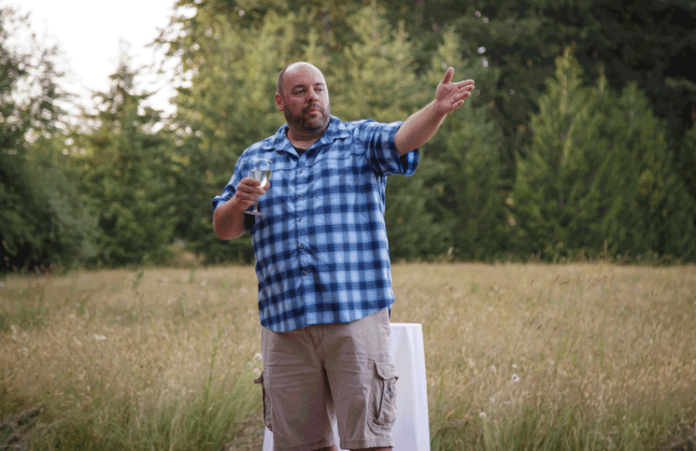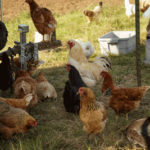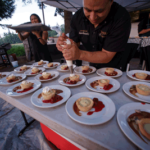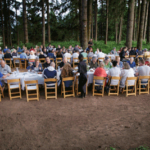As far back as his early 20’s, Mark Lopez felt a nagging sense to do more than collect a paycheck. He wanted to create something that inspired community and left the earth a little better than he found it.
It took him another two decades to fully realize his vision, but on June 30, life experience and passion came full circle when Lopez welcomed more than 100 attendees to his La Center property, Gather and Feast Farm, for the first in a series of multi-course farm-to-table dinners.
A chef’s journey
Growing up in San Diego, Lopez’s culinary foundation was laid by his Grandma Lopez whose specialty was her tamales. His mother fed Lopez’s curiosity in the kitchen next to his brother.
“She (my mother) was the greatest influence to me and my brother from a very young age,” said Lopez. “She had us helping in the kitchen in kindergarten. When we were seven or eight, my brother and I would meal plan; pick the meal, shop for it and then make it. That’s catering right there.”
Lopez landed his first restaurant job at 14 and, after helping at a short-lived, family-owned taqueria in Huntington Beach, California, he seized an opportunity to move to Las Vegas and ended up working for James Beard chef Mark Miller, who Lopez refers to as the godfather of Southwestern cuisine. That experience was a turning point for him.
“It wasn’t until then that I thought of myself as having any artistic talents,” said Lopez. “Working there blew my mind and expanded on the simple foundation that growing up in San Diego gave me.”
In an attempt to merge his love of snowboarding with cooking, Lopez was nearly committed to a move to Lake Tahoe when his father phoned him from out of the blue to tell him about a restaurant space in Portland that he had to check out. At 25 years old, Lopez moved to the Pacific Northwest and opened Baja Grill Restaurant and Taqueria (827 SW Second Ave., Portland).
Over the years, Lopez added catering and his first major client was Enron. After the Enron scandal, he once again changed his focus and eventually rebranded to Crave Catering, which he still operates today.
In the early 2000s, Lopez purchased a small farm in Battle Ground. On his 2.25-acre site, his then-pregnant wife decided to sell her horse, giving Lopez – a self-professed “tomato-holic” – the room to increase his growing area. He took the excess produce to Crave Catering and began working toward defining what a self-sustaining catering business could look like.
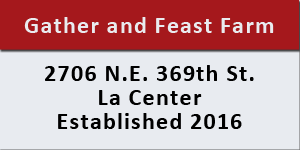 In February of last year, Lopez looked at his growing family (a son and daughter) and made the decision to relocate from Battle Ground to La Center; Gather and Feast Farm was born. The family now enjoys over an acre of planted vegetables, more than 60 laying chickens and room to grow.
In February of last year, Lopez looked at his growing family (a son and daughter) and made the decision to relocate from Battle Ground to La Center; Gather and Feast Farm was born. The family now enjoys over an acre of planted vegetables, more than 60 laying chickens and room to grow.
“When she was born (his daughter, Lilee), it was a reminder that I wanted to work from home and be home more,” said Lopez. “I wanted to grow my own vegetables (and) raise my own livestock and have on-site events.”
Farm-to-table success
Attendance at the June 30 dinner exceeded Lopez’s expectations with 115 guests paying the $100 ticket price to partake in a locally-procured, multi-course meal. Quail, broiler hens and fresh herbs were supplied by Gather and Feast, and Vancouver’s Sprout and Blossom Farm provided produce. Wine from Ridgefield’s Koi Pond Cellars was featured throughout the evening and the cornucopia of flavors was capped off with some of their Elle’s Crème Brûlée in lavender cream tartlet.
With future events scheduled for August 26, September 9 and September 30, Lopez plans to continue to expand his locally-grown network, including cheese from Ridgefield’s Cloud Nine Farm and collaborations with guest chefs like Simply Thyme Catering and nationally-recognized chef, Sebastian Carosi. Carosi is known for foraging and will source in-season wild ingredients from Gather and Feast’s 20-acre site.
“We think what we’re doing ought not to become a lost art form,” said Lopez. “I heard a stunning statistic at a small farms conference: In 1790, 90 percent of the population farmed. By 1900, only 38 percent farmed and, in 2010, it was only 2 percent. I thought, ‘holy smokes, that’s quite a shift and quite a change’ and that 2 percent (is what) we’re all relying on. For me, personally, I don’t want to lose that.”




